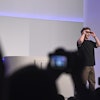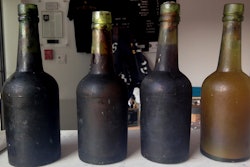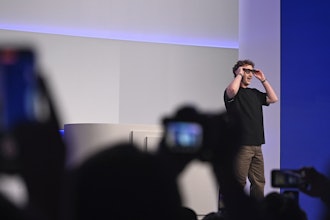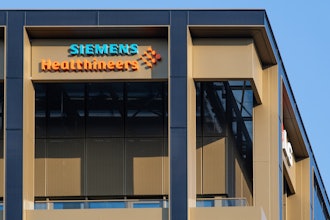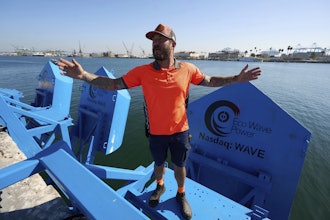We have reached the third week in February and that means that I have finally had a chance to wind down from the three-day event in Anaheim. Three days, five events all co-located at the Anaheim Convention Center in Anaheim, CA. The sign says that this is where manufacturing minds meet, but all of the minds still couldn’t come up with a name for the event.
The event included 21,043 attendees and 1,916 exhibitors spanning everything from design engineering and manufacturing to packaging, plastics and automation.
While it is logistically impossible to visit every booth at the show, here are the top five technologies that I saw:
#5 - Cold Jet: Dry Ice Cleaning System
It was one of the last stops during my trip, so maybe that's why it stuck in my mind -- or maybe it was the Harley in the booth that was covered in a high density polyurethane foam.
Cold Jet is a dry ice cleaning system that is non-abrasive, and stays dry throughout the cleaning process. It has various uses in the medical, packaging, automotive and plastics and rubber markets, primarily de-flashing and deburring low volume, high value parts. Also, it can clean the foam off a Harley without leaving a scratch.
According to Steve Wilson, the global business unit director for plastics, rubber and composites, one of the biggest potential uses is the ability to clean injection molding molds at operating temps, which saves time and can make the process easier.
As Wilson told me, "Molding has progressed a lot in 30 years, but not the cleaning." This dry ice cleaning system just might change that.
#4: TT Electronics: Tiny Components
UK-based TT Electronics acquired Brooklyn Center, MN-based Precision because of the company’s expertise in very small design, simulation and manufacturing. Precision, which does 50 percent of its business in medical implantables like pacemakers and neuromodulators, creates components that power these sensor-enabled implants -- think preventative maintenance, but for the body. At the show, I met with business development manager Shahab Shahbaz to talk about how TT manufactures thes tiny coils that allow implants to conductively power-on and provide additional power that helps transmit data.
According to Shahbaz, the company makes the custom instrumentation that they use to handle and wind very fine wire. One metal core Shahbaz showed me had 2,200 turns of 58 AWG wire -- that's about a tenth the size of the human hair. I mean, I was curious as to why they had to be so small, but some of these implants go into your eye to treat glaucoma, or into your brain to treat epilepsy. As for future applications, Shahbaz noted new work on an implant that helps treat sleep apnea and a neuromodulation implant that may help treat drug addiction.
#3: Formlabs: 3D-Printed Elastic Resin
In January, Formlabs released a new Elastic Resin, the company's 18th new material that can be 3D printed on the Form 2 desktop stereolithography (SLA) printer. Formlabs created the material because customers were looking for a 3D-printed material that mimicked silicone. The material is ideal for medical device prototypes as well as realistic brain and heart models that are used for surgery prep.
At the show, I spoke with Glen Jackman, the growth marketing manager at Formlabs. Jackman says that one of the exciting aspects of working for a company that has shipped more than 40,000 printers is the application diversity. Most recently, he saw 3D-printed parts pop up in high-pressure deep sea applications as well as a cryogenic freezing applications.
#2: Universal Robots: Cobots at Work
Universal Robots (UR) once again impressed with a trio of applications from collaborative robot integrators. The applications shouldn’t be too hard to find now that UR has up to 60 percent of worldwide market share and approximately 31,000 installations.
The first application was a screw driving application from Visumatic. The Kentucky-based company has taken a UR cobot and created the VCM-3X.2 Collaborative Screw Driving Package. Capable of handling multiple screw-driving feeds and routines, the fastening system is designed for machine builders and includes an automatic feeder, a programmable drive system, a skeleton robot program and end effector (the cobot’s hand). Bit position sensors and fastener delivery confirmation also make sure that the operation is repeatable.
Next was XPAK’s ROBOX, a robotic case erecting system. Using a UR10e cobot, the beauty of the ROBOX is that in can put together any size box without changeover. The XPAK uses a multipurpose gripper which picks up the box, takes it to a “flipper” and then a “horn” before it is taped and then dropped. According to William Reilly, Technical Sales with XPAK, the best part is that the machine could be dropped right in to a manual packline.
The most impressive application was the CNC Communication URCap from ID-based VersaBuilt Robotics. The URCap was initially launched to tend Haas CNC machines. It has a pre-packaged interface that can perform any machining program stored on the CNC through the cobot's teach pendant.
According to Truman Lum, regional and OEM sales manager with Versabuilt, the beauty is that you can essentially automate your Haas at a $400 price point. Lum says that the URCap could help fill the huge need for machine-tending manpower.
Haas has also seen the benefit of swapping out the risk, time and cost associated with the human element. Next, VersaBuilt will develop UR interfaces for other popular CNC machines later this year.
#1: - Bosch Rexroth
According Mike Vandemortel, senior sales engineer at Bosch Rexroth, all things industrial need to be IoT-enabled by 2022.
Bosch Rexroth showed off how such connectivity can become a reality through IoT-enabled automation, assembly and handling in the company's vision of the Factory of the Future.
The first demo was the Mechatronics @ Work cell which allowed attendees to order a customized golf ball sleeve using a tablet to select the desired stack of three colored golf balls. Once the order is entered, the job is processed and tracked throughout the production flow and the status is displayed live on the i4.0 Cube display.
Some of the more impressive elements of this display include the IoT Gateway Rack, which connects all areas of production from sensors to machine data; and the IndraDrive Mi, a cabinet-free drive system that decreases machine footprint by reducing component count and using 90 percent less wiring. According to Vandemortel, OEMs are trying to eliminate the cabinet and upgrade without adding floor space, they want to design without a cabinet.
What I found most impressive was the company’s Digital Linear Motion Technology demonstration. The demo showed off some of the company's configurators, but it also showed an example of commissioning and starting production on a new machine.
A performance dashboard provided real-time stats, such as mileage traveled as well as lubrication intervals for predictive and preventative maintenance on motion components. It also provided maintenance alerts on a touch screen overlay that could help solve problems by providing access to videos, manuals or even buying new parts -- right on the machine. That, and the gimmick was a claw machine, and I'm a sucker for a claw machine.
Overall, it was a successful event filled with some cool tech that really stands to disrupt the industry.
Hayley Haggarty, event director of the Anaheim Show, told IEN, “The success of the Anaheim event highlights the major impact smart design and manufacturing technology is placing on a variety of industries. There is going to be a continuing demand for solutions in miniaturization, biocompatibility, connectivity, cybersecurity, 3D printing, smart factories, collaborative robots to name but a few. We expect 2020 to bring more emphasis around these technologies and look forward to next year’s event to showcase even more next-gen solutions.”
You know what Hayley? Me too.

